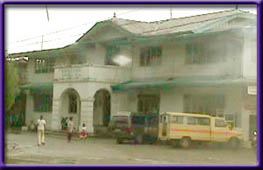| MUN. OF BAROTAC NUEVO |
| MUN. OF BAROTAC NUEVO |
Mayor:
Pedro B. Hautea
Vice
Mayor: Antonio B. Belluga
 Barotac
Nuevo, home of illustrious people, of Iloilo’s cream of the crop. People
who are gentle, gracious and charming. Barotac Nuevo, a premier municipality
in the forefront of development. A municipality with a glorious yesterday
and a promise of an even brighter and rosier tomorrow.
Barotac
Nuevo, home of illustrious people, of Iloilo’s cream of the crop. People
who are gentle, gracious and charming. Barotac Nuevo, a premier municipality
in the forefront of development. A municipality with a glorious yesterday
and a promise of an even brighter and rosier tomorrow.
The recognized leader of the place founded the town in 1811 during the Spanish era, Don Simon Raymundo Protacio Belen. The name Barotac Nuevo was derived from the acronym of the Spanish word baro meaning mud, and tac the last syllable of the Ilonggo word Malutac. Nuevo that means new, was added to identify it from the town 30 kilometers up north called Barotac Viejo.
According to the native lore, Barotac Nuevo during the 15th century was known far and wide with its pure breed horses. And Tamasak, a white stallion was the strongest, fastest and handsomest horse in the locality. Tamasak was destined to be Barotac Nuevo’s symbol. How and why is an interesting story. At that time, the Governor-General of the country was Manuel Gonzales de Aguilar. One time, de Aguilar was given a handsome horse that came from India, but there was no horse around Manila, which could be used as its pair to draw the Governor-General ‘s carromata. De Aguilar’s men went around the islands looking for another horse until they reached the town of Dumangas in Iloilo. Malutac then was only an arrabal of Dumangas. They found Tamasak and wanted to buy the horse at any price but Don Simon would not sell it although he was willing to give it for free provided Malutac be made a pueblo.
The men went back to Manila and informed the Governor-General of Don Simon’s request. The Governor-General agreed and immediately ordered the Gobernadorcillo of Iloilo to separate Barrio Malutac from the town of Dumangas and proclaim its town hood identity. The rest is history.
Through the years, Barotac Nuevo has been considered one of the prosperous and peaceful towns in Western Visayas. Its progress is attributed to its bountiful natural resources. It has one of the highest per capita income in the province of Iloilo.
The municipality of Barotac Nuevo, Iloilo is 30 kilometers away from the city of Iloilo. Located in the northeastern part of the province. Transportation is available via jeepneys and buses.
29
Land Area
9,787.69 has.
Land Use
Agricultural area comprises the bulk of the total land area with 7,154.35 has. or 73.10%. Of these area, 3,987 has. or 58.73% are rice fields; 3,000 has. or 41.935 are sugarcane fields; the remaining area of 425.82 or 6.01% are planted with other crops such as corn, coffee, bananas, root crops, vegetables, fruit trees, legumes and coconuts.Industrial area total to 8.4576 has. or 0.09%; 279.32 has. or 2.85% are Built-up areas; 2,000 has. or 20.40% are fishpond areas; 76 has. or .78% are forests area; 104.6 has. or 1.07% are Parks/Open Grasslands. Rivers, Creeks and Swamps total to 164.87 or 1.68% of the total area of at the municipality.
Topography
Barotac Nuevo is mostly plains. Its highest peak, which is shown in Mt. Salihid, is 132 meters above sea level followed by the Andagao Mountain at 87 meters above sea level. Land elevation is from 0 to 123 meters above sea level and is 122 degrees, 42’ min. longitude, 10 degrees and 53’ min. latitude. The Jalaur River is the principal drain canal of water from the mountains. This is supported by the Tinori-an River and the Jalaur River of which water flows out to the sea.Soil Types
There are 11 different types of soils in the Municipality based on genetic and morphological characteristics. Generally, the town’s soil is fertile which is suitable for most types of agricultural crops. There is a predominance of loam soil in the area, which is conducive to farming.Barotac Nuevo has 3 soil types:
- Soils of the swamps and marshes
- Soils of the plains - Sta. Rita Clay Loam
- Soils of the mountains - Farson Clay
Mineral Resources
Sand and Gravel
Flora and Fauna
Various species of trees are found at Mt. Andagao and Mt. Salihid, (e.g. Mahogany, Ipil-Ipil, Gomelina, Kebe and others). Mangrove trees are found along Coastal areas.Blue Crabs, Clamps, Shrimps, Oysters, Brown & Green mussles, Angel Wings (Diwal) Pelagic Fishes, Depersal Fishes, Aquatic Birds (e.g. King Fishers, Egret & etc.)
Total population of 40,968 (NCSO 1995)
- Intrupahan Beach Resorts
- Punta Ngirit Beach Resort